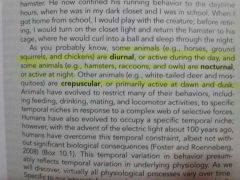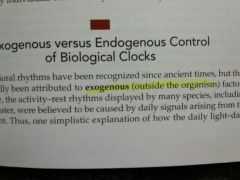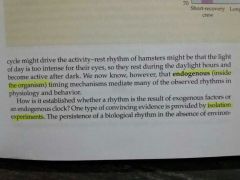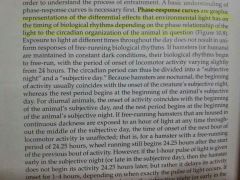![]()
![]()
![]()
Use LEFT and RIGHT arrow keys to navigate between flashcards;
Use UP and DOWN arrow keys to flip the card;
H to show hint;
A reads text to speech;
30 Cards in this Set
- Front
- Back
|
Diural vs Nocturnal vs Crepuscular animals |

Diural: active during the day.
Nocturnal: active at night.
Crepuscular: active at dawn or dusk. |
|
|
What is chronobiology? |
It is the scientific study of biologicalclocks and their associated rhythms. |
|
|
Why chronobiology took so long to develop as scientific discipline? |
This is because it had to counteract the dogma of homeostasis in the biological sciences and medicine. |
|
|
Rhythm |
a recurrent event that is characterized by its period, frequency, amplitude, and phase. |
|
|
Period (in terms of rhythm) |
the length of time required to complete one cycle of the rhythm in question. |
|
|
Frequency (in terms of rhythm) |
computed as the number of completed cycles per unit of time. |
|
|
Amplitude (in terms of rhythm) |
the amount of change above and below the average value, that is also the distance of the peak or nadir from the average. |
|
|
Phase (in terms of rhythm) |
a point in the rhythm relative to some objective time point during the cycle. |
|
|
Exogenous |

OUTSIDE the organism. |
|
|
Endogenous |

INSIDE the organism. |
|
|
__________ experiment is used to determine whether a rhythm is due to exogenous or endogenous factors. |
(fill in the blanks) isolation |
|
|
Can biological rhythms persist in the absence of environmental cues? |
Yes. |
|
|
|
De Mairan's report. |
|
|
What is the important experimental technique used in the study of biological rhythms? |
By keeping a log of physical activity over time. Do so by monitoring activity cycles. |
|
|
Zeitgeber |
events that keep our circadian rhythms regulated. |
|
|
Example of natural zeitgeber |
alternation of the light/dark cycle of a 24 hour day. |
|
|
Example of artificial zeitgeber |
Alarm clock |
|
|
What is the common method of measuring rhythms in locomotor activity if rats? |
By using the wheel-running apparatus. |
|
|
What is entrainment? |
The process of synchronization of endogenous biological rhythms with a periodic cue in the environment - a zeitgeber. |
|
|
Phase-response curves |

graphic representations of the differential effects that environmental light has on the timing of biological rhythms depending on the phase relationship of the light to the circadian organization of the animal in question. |
|
|
What does estrogen do to the clock function in the body? |
Estrogen accelerates clock function. |
|
|
What does progesterone do to the period of activity cycles? |
Progesterone lengthens it. |
|
|
Light affects the rhythm of _____________ secretion. |
Melatonin. |
|
|
Melatonin is produced by the _____________ (name the gland) during the dark phase of the day, which results in sustained elevation in the blood levels of this hormone. |
Pineal gland |
|
|
When does steroid-dependent behaviors of animals wane? |
When animals become reproductively quiescent. |
|
|
When does steroid-dependent behaviors of animals recur? |
During breeding season, when reproductive hormones are again secreted. |
|
|
What is the "master clock"? |
the master clock controls the circadian rhythms, which consists of a group of nerve cells in the brain called suprachiasmatic nucleus (SCN). |
|
|
How circadian rhythm affects body function and health? |
it can influence sleep wake cycles, hormone release, body temperature, other bodily functions. |
|
|
What is the hormone that makes you sleepy? |
Melatonin. |
|
|
What is the hormone that serves as waking function? |
Serotonin. |

